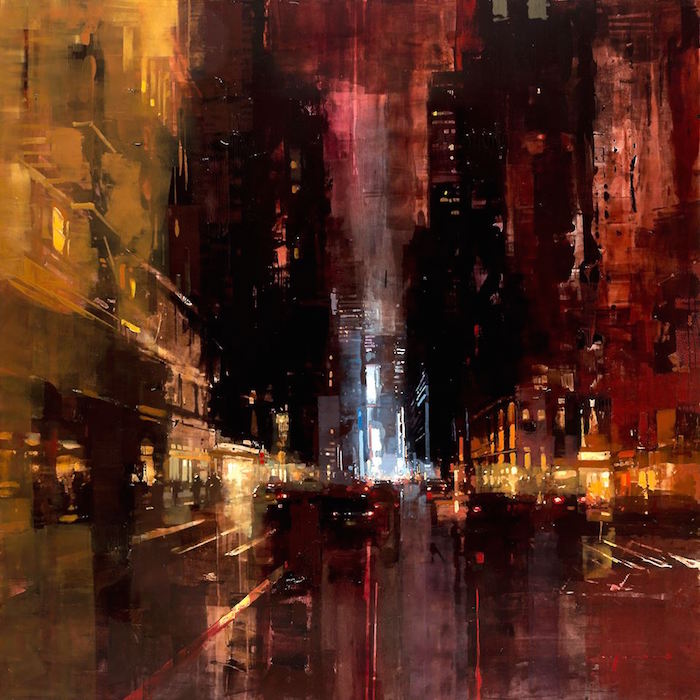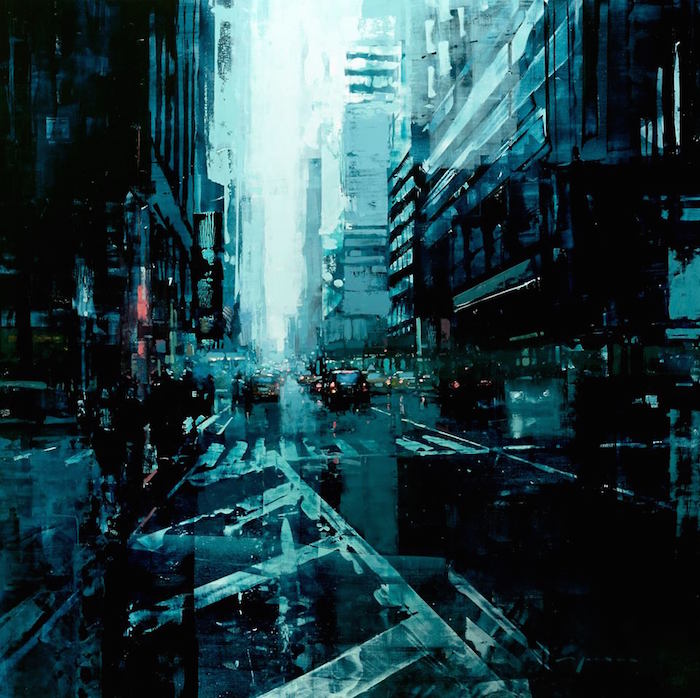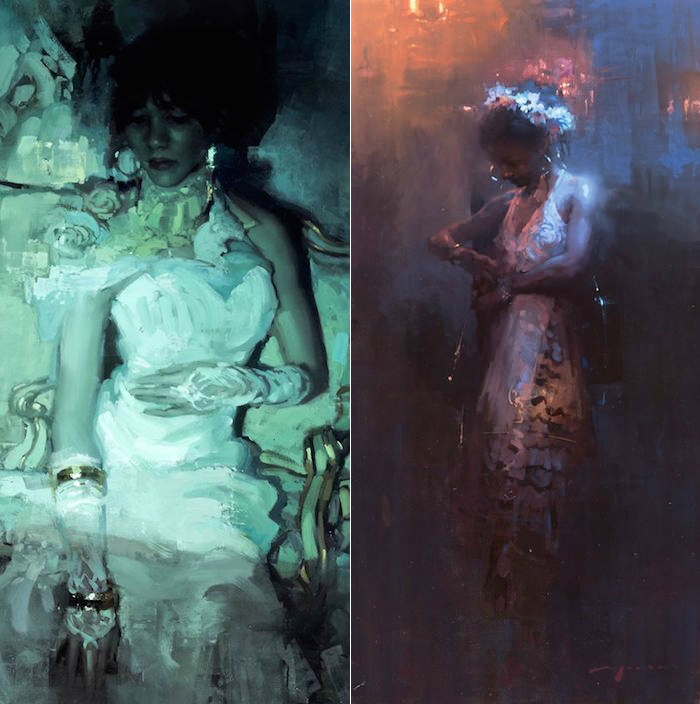All images courtesy of the artist
Late one night, in the days when he was a "drunken depressed art student," Jeremy Mann came back to his studio and started picking up every random object he could find, trying to paint with each. This went on into the morning, when he took in the resulting mess. "What I had created was a large piece of garbage," the Ohio-raised and Oakland-based artist tell us. "But one mark sang so beautifully amongst the crisscross of crap." That mark was created with a broken ink roller, which lay on the ground amid a pile of cardboard, sticks, markers, bottles, latex, and charcoal; all discarded as useless tools. "I immediately bought all the types and sizes I could, and set my mind to figuring out how to harness that mark in every way I could, effectively making that mark mine."He's refined that technique of using rollers, even adding printing squeegees into the mix, and from it he's harnessed an elegant and clean style that belies much of the carnage that went into creating it. The angular shapes, glowing colors, and transparent layers look very mathematical and almost digital. Even his level of output adds to the feeling that they were created with software rather than oil paints. There's an energy in the pieces, whether it's the dense cityscapes that are a common subject in his work, or whether it's simply the lines from his paint. The physical motion is very clear. But the clarity and serenity they evoke comes from a scene of chaos. In his studio, he curses heavily, sometimes dances, throws things at the wall, and gets giddy over certain strokes. "The entirety of emotions within me are released in that private space, absorbed from my life and wrung out within those walls," he says.The aesthetics of his work match well with graphic design, but he has a deep dislike for the digital world. In a previous interview, he raged against it: "I loathe digital. From the effect it has upon our social lives, the frustrating inability to install a program that works fluidly with other programs, all the way to the overpowering and unnatural amount of detail in a digital photograph."It's not a total aversion to all things modern though. He takes full advantage of Instagram and social media, posting his numerous painting with a heavy frequency.
There's an energy in the pieces, whether it's the dense cityscapes that are a common subject in his work, or whether it's simply the lines from his paint. The physical motion is very clear. But the clarity and serenity they evoke comes from a scene of chaos. In his studio, he curses heavily, sometimes dances, throws things at the wall, and gets giddy over certain strokes. "The entirety of emotions within me are released in that private space, absorbed from my life and wrung out within those walls," he says.The aesthetics of his work match well with graphic design, but he has a deep dislike for the digital world. In a previous interview, he raged against it: "I loathe digital. From the effect it has upon our social lives, the frustrating inability to install a program that works fluidly with other programs, all the way to the overpowering and unnatural amount of detail in a digital photograph."It's not a total aversion to all things modern though. He takes full advantage of Instagram and social media, posting his numerous painting with a heavy frequency. While the paintings may not actually contain the reams of data they appear to hold, they're full of information concerning the movements made while making the pieces. That physicality is central to the end result. "I like a freshness and an explosion, or a quiet moment once and gone," Mann explains. "The marks are made with immediacy and haphazard accuracy, it’s incredibly nerve wracking. But this process has given me the peace to think between layers and react with knowledgeable urgency as I create each piece." The marks that he considers intrinsically "his" come from very time sensitive techniques.This also leads to the speed of his output. He paints multiple pieces at once, partially because things need time to dry, but also because he gets bored easily and likes to move around a lot. The speed is further a result of the intimate familiarity with his style.But he’s constantly trying out new styles, actively stepping out of his comfort zone: "I just recently discovered I like gouache (and all the many ways to misspell it) for plein air paintings, but I’ve also developed a hatred for watercolor. The process is simply backwards and it hurts my brain, which is why I keep wanting to figure it out." And it gets much more experimental than that. He's tried doorstops, windshield wipers, wine and whiskey bottles in place of brushes. "Even that banana which turned out to actually be a good blending tool, painting with lettuce, though, I can tell you might be useless. In this process of experimenting with tools, an artist inevitably discovers new techniques as a result of accidents and learning how to recognize those accidents as worthy or not, and then harness them or bury them."
While the paintings may not actually contain the reams of data they appear to hold, they're full of information concerning the movements made while making the pieces. That physicality is central to the end result. "I like a freshness and an explosion, or a quiet moment once and gone," Mann explains. "The marks are made with immediacy and haphazard accuracy, it’s incredibly nerve wracking. But this process has given me the peace to think between layers and react with knowledgeable urgency as I create each piece." The marks that he considers intrinsically "his" come from very time sensitive techniques.This also leads to the speed of his output. He paints multiple pieces at once, partially because things need time to dry, but also because he gets bored easily and likes to move around a lot. The speed is further a result of the intimate familiarity with his style.But he’s constantly trying out new styles, actively stepping out of his comfort zone: "I just recently discovered I like gouache (and all the many ways to misspell it) for plein air paintings, but I’ve also developed a hatred for watercolor. The process is simply backwards and it hurts my brain, which is why I keep wanting to figure it out." And it gets much more experimental than that. He's tried doorstops, windshield wipers, wine and whiskey bottles in place of brushes. "Even that banana which turned out to actually be a good blending tool, painting with lettuce, though, I can tell you might be useless. In this process of experimenting with tools, an artist inevitably discovers new techniques as a result of accidents and learning how to recognize those accidents as worthy or not, and then harness them or bury them."

 To learn more about Jeremy Mann’s work, click here.Related:Painting’s Evolution in the Digital AgeStreet Photos Look Like Paintings in 'Urban Melodies'Swipe Right on These "Abstract Technical" Artworks
To learn more about Jeremy Mann’s work, click here.Related:Painting’s Evolution in the Digital AgeStreet Photos Look Like Paintings in 'Urban Melodies'Swipe Right on These "Abstract Technical" Artworks
Advertisement
Advertisement
Advertisement